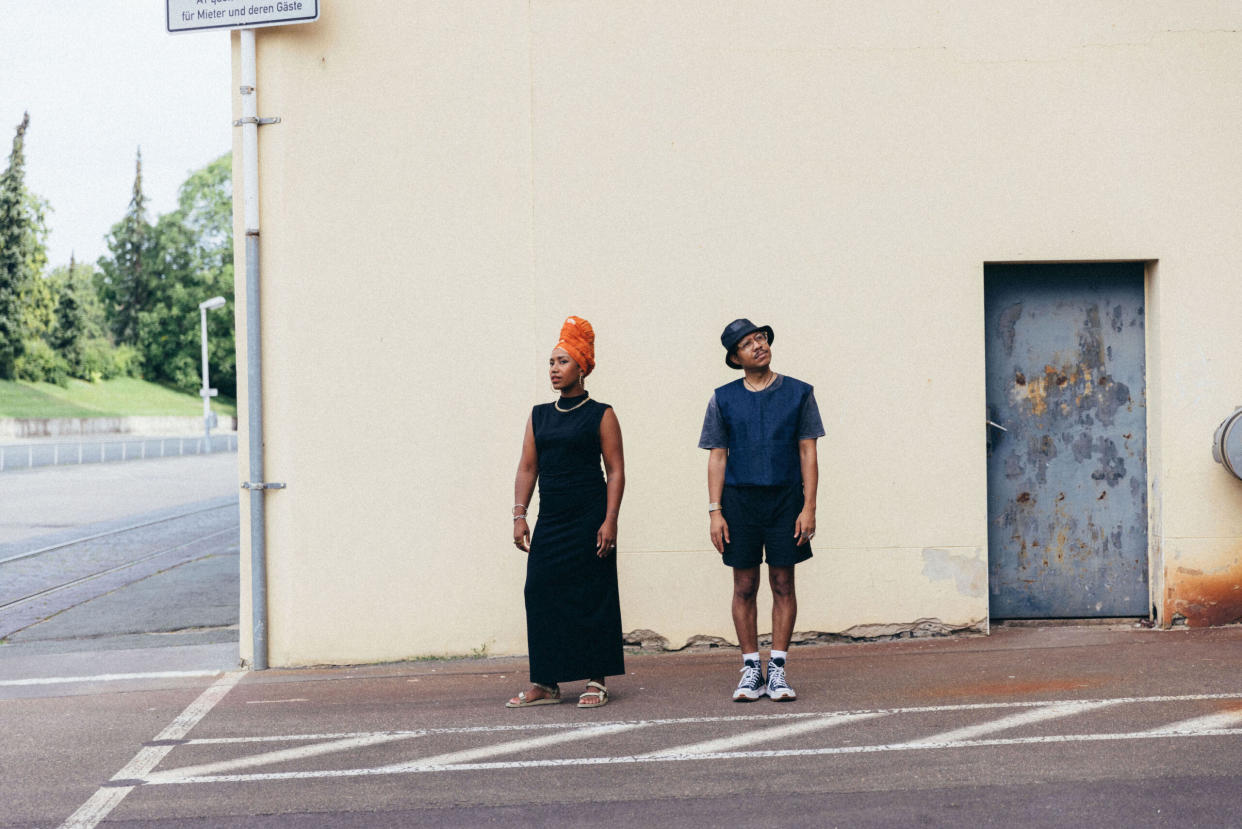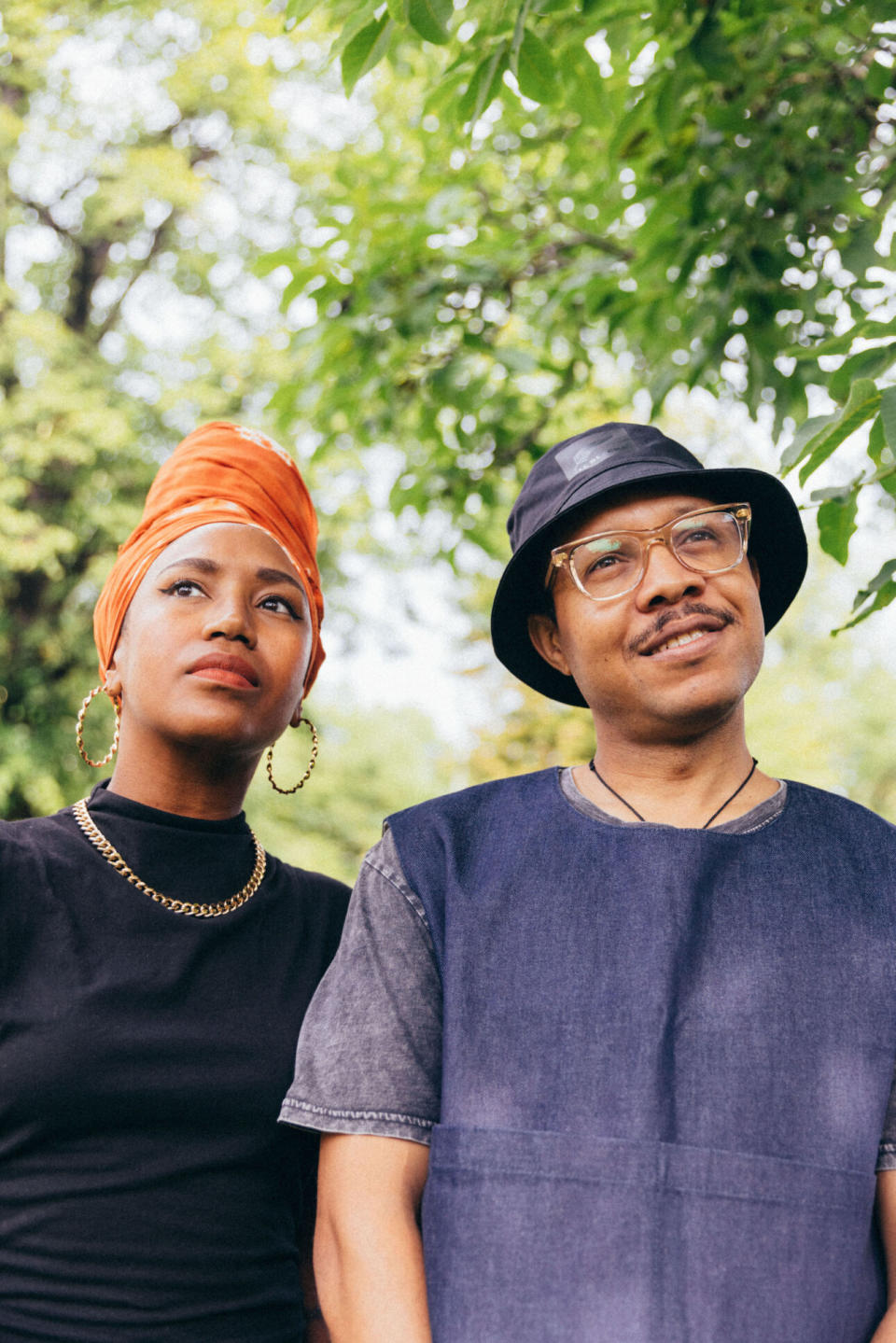groundsound Wants You to Listen to These Drums

- Oops!Something went wrong.Please try again later.

Live at Pop Montreal, in the waning days of the sticky 2023 summer heat, long before their debut album was available, the duo known as groundsound took the stage in bright, ruffled costumes that shimmered as they moved to the bass. The Riddim Writer—who, in another life, is Isis Semaj-Hall, literature professor at the University of the West Indies—drew the audience in alongside Gavsborg, a.k.a. Gavin Blair of the venerable Jamaican group, collective, and label Equiknoxx. The combination of story, stage presence, and sound drew in the crowd throughout their too-short set.
Thank goodness for the February release of their first outing, Working Progress. An infectious, beat-driven project, groundsound arose from what Blair calls “likemindedness.” They met at Anchor studios, owned by producer and mutual friend Augustus “Gussie” Clarke, who throughout his four-decade career has worked with artists like U-Roy, Dennis Brown, Maxi Priest, and Shabba Ranks. “We spoke a lot about Kumina,” Blair explains, mentioning the traditional Afro-Jamaican religion and dance form involving rituals, drumming, music, and trance-like movements where participants can become possessed by ancestral spirits. “This interest put Nicholas ‘Nick’ Allen [a Kumina teacher] on our radar. After brief links with Nick, we started creating music together that incorporated Kumina sounds.”

This led to a performance at the 2019 International Charles Town Maroon Conference in Portland, Jamaica, which laid the groundwork for groundsound. “Maroon” refers to a person who escaped from enslavement or descended from those who escaped. Maroons formed communities in remote areas of Jamaica, building African- and Indigenous-influenced societies and resisting re-enslavement. The conference brings together academics and the island’s Maroon community around issues of Indigenous sustainability and Maroon culture. “I don’t know if we were totally sure that people would understand what we had done,” describes Semaj-Hall. “In the studio, we were like, this is it. We see everything.”
When their music was performed, the audience “seemed to understand, and importantly, they moved as well.” That first experiment, which rounds out the album as “Sonic Uprising,” contains vocals based on WhatsApp texts, Kumina drums, and some broken beat business.
groundsound straddles styles, forcing a reliance on way too many adjectives: poppy, poetic, bass-driven, housey, folky, electronic, organic, but all made to make you think and move, in whichever order strikes your fancy. It’s hard not to draw comparisons with dub, the Jamaican genre known for manipulation and rearrangement of sounds. Semaj-Hall playfully equivocates a little on this point: “It depends on how [someone’s] understood dub, how they’ve been thinking about dub, but how we are approaching the music, I think is very much in line with how dub music and dub processes work. So sometimes it’s kind of a subverted message, packaged, obscured, tucked over here, hidden around this corner.”

All good storytellers draw the listener in, and in each track groundsound offers up a tantalizing image or idea that you want to know more about. The album kicks off with a description of a train—the “Obeah 5.” We’re invited to step onboard and look around, then offered a variation of “I’ve Been Working on the Railroad” (courtesy of the sweet tones of Jamaican outfit Earth and the Fullness). The overall feeling is that of being taken on a trip, and the movement doesn’t let up for the balance of the album.
But don’t get distracted by just how much Working Progress elicits head nods and begs for boogie (try not to dance to the amusingly titled “we had a QUALITY TIME dubbing these drums”). Kat7, another Gavsborg project with vocalist Exile Di Brave, offers assistance on “Put on an Iron Shirt,” a song inspired by, as Semaj-Hall explains, “Africans brought to Jamaica who were actually responsible for the developments having to do with wrought iron and English folks [who] had been taking credit for their work for hundreds of years.
“And so that wrong was being righted at that time,” she continues. “Gavin sent me the article. He’s like, ‘Hey, what do you think? Do you have words for this?’ And I was like, ‘I might have some words for this, actually.’”
Whatever creativity emanates from Semaj-Hall is matched by Blair. The innovation and originality that informs groundsound isn’t surprising—with Nick ‘Bobby Blackbird’ Deane, Jordan ‘Time Cow’ Chung, Kemikal and Shanique Marie, Blair has been instrumental in some of the most exciting Jamaican music of this century. From hardcore dancehall (check Aidonia’s graphic “Flying Dagger aka 100 Stab”) to the experiments in melody and rhythm (2021’s Basic Tools is a good example), Equiknoxx takes the crew ethos seriously, drawing inspiration and assistance from a huge range of local talent—every project draws on the talents of the wider collective. The approach to groundsound appears to be similar.
Equiknoxx blossomed in a Kingston yard, “full of people that didn’t really have access to anything. No radio, no selectors and no dance was playing any of what we were doing,” explains Blair, “so it was just really about making music for us in the yard.” groundsound, however, has to function transnationally—as Semaj-Hall lives and works in Jamaica, and Blair, though hailing from the same island, presently finds himself in Berlin. Learning about how the project was also born in a yard, developed over lots of chats—live and on WhatsApp—meant speaking to each member at different times, and getting different impressions of how groundsound came to be at Equiknoxx studio in Kingston, and other studios in Barbados and Berlin.
“Music can feel like an exorcism,” states Semaj-Hall, “You can release something through the exercise of dancing of motion.” And the music stems from motion—as Blair puts it, in the studio is where he lays it all down, “but mostly it’s from travels, whether locally, internationally, even going for a little walk around the block where I live.”
To see our running list of the top 100 greatest rock stars of all time, click here.

